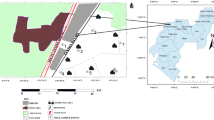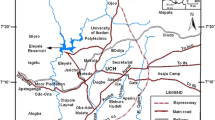Abstract
Open dumping is becoming a fast-spreading bad phenomenon across the globe. The groundwater systems and ambient soil remain the major hotspots of the dumpsite leachate plumes activities. An electrical resistivity survey and hydrochemical investigations were undertaken within and off-dumpsite to assess the environmental impacts of the dumpsite leachates. Schlumberger method was used to acquire twenty-nine (29) vertical electrical sounding (VES) points across two orthogonal traverses established within and off-dumpsite to investigate the level of impacts of the dumpsite leachate plumes on the soil and groundwater resources. While the protective overburden soil layers resistivity values vary between 2.4 and 217 Ωm within the dumpsite, the off-site varies between 117 and 1313 Ωm. The study indicates that the overburdened soil layers overlying the weathered/fractured unit, which constitute the aquifer systems of the region, were suspected to have been compromised by dumpsite leachate plumes as indicated by the low resistivity values characterizing the subsoil layers. The hydrochemical analysis of water samples from the investigated six hand-dug wells (HDWs) shows the presence of heavy metals (HMs). The results of the laboratory analysis of the water sample indicate a high content of electrical conductivity (0.699–1.221 mg/l), iron (0.782–1.9181 mg/l), lead (0.871–1.992 mg/l), chromium (0.333–0.512 mg/l), and cadmium (0.0211–0.0419 mg/l), while the high contents of chemical oxygen demand (COD) (459–561 mg/l), biological oxygen demand (BOD) (902–1017 mg/l), and total dissolved solids (TDS) (597–1301 mg/l). The high content of BOD and COD in the dumpsite leachate plumes shows high organic potency. However, it was noted that the concentration decreased as the pollutant source distance increased, while the shallow depth seems to have been more impacted. Geophysical and hydrochemical data show that the degree of the impacts of the dumpsite leachate plumes seeping the ground down the water table is a function of depth, source distance and subsurface properties. Both techniques confirmed the infiltration of leachate plumes into the soil and groundwater systems posing a great risk to public health. Therefore, to obtain clean and portable drinking water, it is suggested that HDWs/boreholes should be sited at least 100 m away from the dumpsite to at least a depth of 15 m.







Similar content being viewed by others
Data availability
All the materials and data used for this research are available for further information.
References
Abdullahi NK, Osazuwa IB, Sule PO, Onugba A (2013) Geophysical assessment of an active open dumpsite in basement complex of North-western Nigeria. Int J Eng Sci Invention ISSN (online). 2(5):12–21 (2319–6734, ISSN (Print): 2319–6726)
Aboh HO, Dogara MD, Alao JO (2016) Evaluation of the geotechnical parameters in part of Kaduna, Kaduna State Nigeria. World J Appl Sci Technol 8(2):108–117. ISSN: 2141–3290; www.wojast.com
Adiat K, Adegoroye AA, Adebiyi AD, Akeredolu BE, Akinlalu AA (2019) Comparative assessment of aquifer susceptibilities to contaminant from dumpsites in different geological locations. Heliyon 5:e01499. https://doi.org/10.1016/j.heliyon.2019.e01499
Alao JO (2023) Impacts of open dumpsite leachates on soil and groundwater quality. Groundw Sustain Dev 20:100877. https://doi.org/10.1016/j.gsd.2022.100877
Alao JO, Lawal HA, Nur M (2023a) Investigation of groundwater vulnerability to open dumpsites and its potential risk using electrical resistivity and water analysis. Heliyon 8:e098550. https://doi.org/10.1016/j.heliyon.2023.e13265
Alao JO, Lawal KM, Dewu B, Raimi J (2023c) The evolving roles of geophysical test sites in engineering, science and technology. Acta Geophys. https://doi.org/10.1007/s11600-023-01096-3
Alao JO, Yusuf MA, Nur MS, Nuruddeen AM, Ahmad MS, Jaiyeoba E (2023d) Delineation of aquifer promising zones and protective capacity for regional groundwater development and sustainability. SN Appl Sci 5:149. https://doi.org/10.1007/s42452-023-05371-2
Ercolano S, Gaeta G, Ghinoi S, Silvestri F (2018) Kuznets curve in municipal solid waste production: An empirical analysis based on municipal-level panel data from the Lombardy region (Italy). Ecol Indic 93:397–403
Fatoba JO, Eluwole AB, Sanuade OA, Hammed OS, Igboama WN, Amosun JO (2020) Geophysical and geochemical assessments of the environmental impact of Abule-Egba landfill, southwestern Nigeria. Model Earth Syst Environ. https://doi.org/10.1007/s40808-020-00991-8
IGRAC (2022) Groundwater, key to the Sustainable Development Goals (SDGs). https://www.un-igrac.org/stories/groundwater-key-sustainable-development-goals-sdgs
Isaac OO, Jonah CA, Joel AO (2010) Assessment of aquifer characteristics in relation to rural water supply in Part of Northern Nigeria. Researcher 2(3):22–27
Machado SL, Santos ÁC, de Fátima Carvalho M, Góes Damasceno LA, Almeida LV, dos Santos AB (2021) Biogas production in a tropical landfill: Long-term monitoring results and analysis of variables of influence. Environ Monit Assess 193:485. https://doi.org/10.1007/s10661-021-09248-y
Ohanu M, Ekeh NF, Ohanu BI, Ohanu MC, Aguzie N, Ivoke N (2020) Evaluation of some heavy metals and physicochemical properties of public refuse dumpsites in Nsukka metropolis, Nigeria. Environ Monit Assess 192:477. https://doi.org/10.1007/s10661-020-08450-8
Ojo OA, Oyelami CA, Fakunle MA, Ogundana AK, Ajayi OE, Uche TE (2022) Integrated approach to unsaturated zone characterization as it relates to burial practices and its impact on the immediate environment. Heliyon 8:e09831. https://doi.org/10.1016/j.heliyon.2022.e09831
Ojuri OO, Ayodele FO, Oluwatuyi OE (2018) Risk assessment and rehabilitation potential of a millennium city dumpsite in Sub-Saharan Africa. Waste Manage 76:621–662. https://doi.org/10.1016/j.wasman.2018.03.002
Olayinka AI (1992) Geophysical siting of boreholes in crystalline basement Areas of Africa. J Africa Earth Sci (middle East) 14:197–207
Omeiza JA, Dogara MD (2018) Aquifer vulnerability to surface contamination: a case of the new millennium city, Kaduna, Kaduna State Nigeria. World J Appl Phys. https://doi.org/10.11648/j.wjap.20180301.11,1-12
Omeiza JA, Abdulwahab OO, Nur MS, Danjuma TT, Emmanuel J, Diya’ulhaq A et al (2022) Effect of an active open dumpsite on the earth’s subsurface and groundwater resource. Asian J Phys Chem Sci 10(2):15–24. https://doi.org/10.9734/AJOPACS/2022/v10i230152
Omotayo AI, Adefila SA, Mustapha TA (2019) Impact of Olusosun landfill leachate on the growth and germination of Celosia Argentea. J Waste Manag Disposal 2:107
Onyekwelu LI, Aghamelu PO (2019) Impact of organic contaminants from dumpsite leachates on natural water sources in the Enugu Metropolis, southeastern Nigeria. Environ Monit Assess 191:543. https://doi.org/10.1007/s10661-019-7719-2
Oseji JO, Egbai JC, Okolie EC, Ese EC (2018) Investigation of the aquifer protective capacity and groundwater quality around some open dumpsites in sapele Delta State, Nigeria. Appl Environ Soil Sci. https://doi.org/10.1155/2018/3653021
Oyawoye MO (1970) The basement complex of Nigeria. In: Dessauvagie TFJ, Whiteman AJ (eds) African geology. University Press, Ibadan
Parvin F, Tareq SM (2021) Impact of landfill leachate contamination on surface and groundwater of Bangladesh: a systematic review and possible public health risks assessment. Appl Water Sci 11:100. https://doi.org/10.1007/s13201-021-01431-3
Peter AE, Nagendra SS, Nambi IM (2019) Environmental burden by an open dumpsite in urban India. Waste Manage 85:151–163. https://doi.org/10.1016/j.wasman.2018.12.022
Roychoudhury A, Chakraborty S (2021) Effect of hydrogen sulfide on osmotic adjustment of plants under different abiotic stresses. In: Khan MN, Siddiqui MH, Alamri S, Corpas FJ (eds) Hydrogen sulfide and plant acclimation to abiotic stresse. Plant in challenging environments, vol 1. Springer, Cham. https://doi.org/10.1007/978-3-030-73678-1_5
Sharma A, Ganguly R, Gupta AK (2020) Impact assessment of leachate pollution potential on groundwater: an indexing method. J Environ Eng. https://doi.org/10.1061/(ASCE)EE.1943-7870.0001647
Telford WM, Geldart LP, Sheriff ER (1990) Applied geophysics. Cambridge University Press, Cambridge
Vaccari M, Vinti G, Tudor T (2018) An analysis of the risk posed by leachate from dumpsites in developing countries. Environments 5:99. https://doi.org/10.3390/environments5090099
WHO (2017) Guidelines for drinking-water quality: fourth edition incorporating the first addendum. Geneva: Licence: CC BY-NC-SA 3.0 IGO. https://apps.who.int/iris/bitstream/handle/10665/254637/9789241549950-eng.pdf?sequence=1
Yusuf MA, Abiye TA, Butler MJ, Ibrahim KO (2018) Origin and residence time of shallow groundwater resources in Lagos coastal basin, southwest Nigeria: an isotopic approach. Heliyon 4:e00932. https://doi.org/10.1016/j.heliyon.2018.e00932
Author information
Authors and Affiliations
Corresponding author
Ethics declarations
Conflict of interest
No conflicting interest.
Additional information
Publisher's Note
Springer Nature remains neutral with regard to jurisdictional claims in published maps and institutional affiliations.
Rights and permissions
Springer Nature or its licensor (e.g. a society or other partner) holds exclusive rights to this article under a publishing agreement with the author(s) or other rightsholder(s); author self-archiving of the accepted manuscript version of this article is solely governed by the terms of such publishing agreement and applicable law.
About this article
Cite this article
Alao, J.O., Fahad, A., Danladi, E. et al. Geophysical and hydrochemical assessment of the risk posed by open dumpsite at Kaduna Central Market, Nigeria. Sustain. Water Resour. Manag. 9, 170 (2023). https://doi.org/10.1007/s40899-023-00948-6
Received:
Accepted:
Published:
DOI: https://doi.org/10.1007/s40899-023-00948-6




